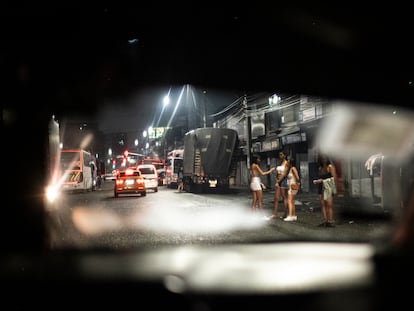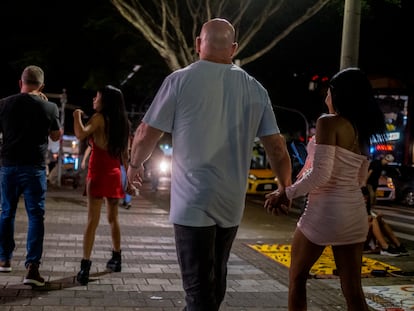Life is hell for the poor in Cartagena, where sexual exploitation starts in childhood
Colombia’s capital of tourism has instituted a plan against sex work and trafficking in central neighborhoods geared towards “reestablishing public order”, but it fails to address the issue’s most basic causes. Many vulnerable families allow and even promote the sale of their children’s bodies. ‘To the police, we are nothing,’ says one woman
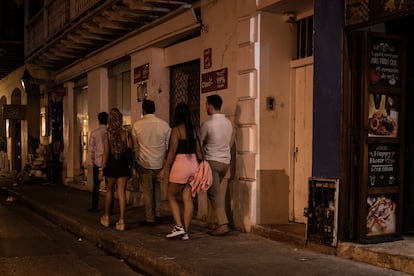

The park benches in Cartagena’s Plaza de los Estudiantes are full on a Friday night in February. On one, several young people drink from beer cans. On another, a man appears to be waiting for someone. In the plaza’s most discreet corner, three women sit, looking in front of them. The police take exception with the latter group, and four officers approach the women, directing them to stand. Two of the young women jump up, but the third stays put, talking on her phone until a cop grabs her. The woman turns, bracing herself and shouting. Beginning in January, the fight against sexual exploitation in the historic center has meant that sex workers are never allowed to rest. Motorcycle police disperse them by blaring their sirens. The plan to remove them from the epicenter of the most tourism-heavy city in Colombia has turned into one to keep them walking. Theirs are the eternal perambulations of the night.
The woman on the phone is nearly dragged to the police station. This Friday, she will spend the night in prison and, her companions say, her young children will wake up at home, alone. The other two women disappear down Candilejo Street, lamenting her bad luck. They actually only met each other a few hours ago. One of them comes from Bucaramanga to Cartagena for a few days every two months to earn the money in the street that she needs to care for her daughter. She’s quite clear on the golden rule: “I always try to be invisible because to the police, we are nothing.” Five years ago, she arrived in Colombia from Venezuela. She is 24 years old, and this is her only source of income.
For the city’s new mayor, Dumek Turbay, the plan to “reestablish public order” that has been baptized Titán 24 is proving to be a success. The closure of numerous locations and the police siege have visibly reduced sex work in the city’s center. The secretary of the interior, Bruno Hernández, proudly explains that during the recent Holy Week, Cartagena received “family, religious and sports” tourists, although he recognizes that prostitution has neither disappeared nor been eradicated, but merely moved to other zones where it is less visible. “Young women say they can make up to five million pesos [$1,284] in one night, there’s no other job that can match that,” says the official.
The image of a U.S. tourist entering a Medellín hotel with two teenaged girls led to a worldwide scandal a few weeks ago, but the same scene is repeated daily in places like this Caribbean city, which is split by inequality into two worlds. Much has been said about clients or abusers, but the most dramatic realities to which these women and girls have been subjected have been the wounds of racism, marginalization and unmet needs. They are the ones who are prohibited from sitting on park benches because they sully the idyllic postcard of itself that the colonial city seeks to sell.
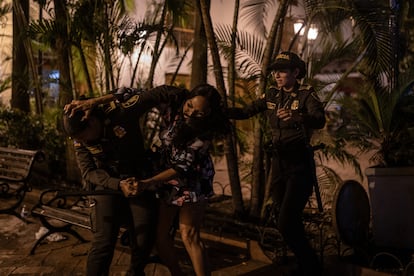
Beyond the Cartagena of colorfully painted building facades, jasmine-covered balconies and streets adorned with colorful pennants that visitors post to Instagram, there lies a world of poverty: 43% of its nearly one million residents have much deeper problems than the center’s urban aesthetic might suggest. These victims of segregation, violence and hunger live at the margins of society and, in some cases, find that sex work is the only tool within their reach when it comes to forming part of a city laser-focused on tourism, and one that seems to have forgotten them.
The childhood abyss
From the streets you can barely glimpse a dozen pairs of eyes that stare like owls. It’s a Friday in April and music leaks out through the iron bars of the entrance gate. Hands braid colorful bracelets on laps amid the voices and laughter of teenagers. There are 50 boys and girls aged 10 years and up living in this house temporarily. They are victims of sexual violence who are now part of a Fundación Renacer [Rebirth Foundation] program, which looks to restore their rights and heal them of the horror they have experienced, both inside and out. Some have suffered from domestic abuse, others have been victims of exploitation — rescued from dire situations — and still others come from vulnerable families in which sex trafficking is both accepted and taught, sometimes for generations, as a way of bringing money home.
Behind closed doors, the work to run the program is exhausting: escapes, returns, relapses, withdrawal, guilt, sadness, anger. The team that accompanies these minors, who are under the protection of the Colombian state, provides them with constant companionship and also facilitates support from psychologists to alleviate the enormous weight they try to lift from the childrens’ shoulders. “The most difficult are the ones who, despite all the love they had for them, were sold or trafficked by their mom or dad,” says one worker. Phrases like “sal a rebuscarte, si no ganas no comes [go out and forage, if you don’t earn you don’t eat]” and “vaya siquiera a mamarla, pero traiga plata [go suck it, but bring back money]” have lost their significance in too many homes along the Caribbean coast. The husband-and-wife duo of 74-year-old sociologists Raúl Paniagua and Rosa Díaz, who have dedicated their lives to the youth of Cartegena, know this all too well.
In this and other regions of Colombia, the paternal figure is very weak. “The prevailing idea is that women are strong and they bring up the children, while there’s a certain tolerance for men who don’t fulfill their responsibilities,” says Paniagua. For generations, children have been raised by a network that extends past their mothers: a grandmother, a godmother, a neighbor in a more comfortable financial situation. The Paniaguas themselves have one biological child and nine foster children. Rosa’s mother, as if straight from a Gabriel García Márquez story, herself raised 20.
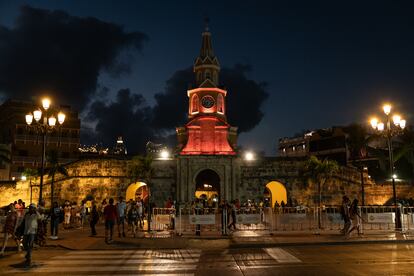
The city used to be a bucolic place to breathe in salt air and history. In 1984, its nearly seven miles of defensive walls were declared a UNESCO world heritage site — until development and lax urban planning fragmented the city into segments, whose realities were as stratified as those of foreign nations. Wealth grew in the heat of international tourism and Bogotá's elite fixed up colonial mansions to serve as their beach homes.
Today, Cartagena is to many the city that lies within those historic walls and the nearby Getsamani neighborhood, and whose peripheral areas don’t matter, or even exist, beyond a brief glimpse from airplane windows during landing. “It was through this idea of hiding poorer, more difficult realities that they began losing their values,” says Panigaua. “Children also became invisible and many began to be considered a financial resource, with their parents’ consent.”
Rural Cartagena
In the village of Arroyo Grande, 40 kilometers from the city, a man to whom everyone refers as “El Extranjero” [The Foreigner] first appeared a year ago. Ten percent of Cartagena’s population reside in these rural areas, in villages and townships where between 80% and 90% of residents live in conditions of poverty or extreme poverty.
In the northern area where Arroyo Grande is located, large-scale tourism has yet to appear, but hotel chains and real estate projects are making plans involving sites that have traditionally been home to Black communities. Airlin Pérez Carrascal, an activist from Movimiento Mujeres Negras y Barriales [Black Neighborhood Women’s Movement], warns of the vulnerability of a population that has always lived under the institutional radar: “Inequality is most notoriously located in the body of the Black woman and girl.”
The Foreigner, a U.S. man who no one calls by his real name, has become popular in this area, where the sight of tourists is unusual. Sometimes he comes, gifts clothing to little girls, and “takes them for a walk,” as a local woman put it, warily. This method is replicated in other, equally poor areas. In the Olaya Herrera neighborhood, which has the highest crime rates in the city, local activists can regularly pinpoint the little girls who, over the course of two months, change the way they dress, begin using brand-name sneakers, start bringing expensive cell phones to school, and are chauffeured in cars or cabs, generating more envy than scandal.
City plan Titán 24
The panorama of the historic center one Friday in April no longer resembles that of the night in February, when a young woman was seen leaving the police station on the way to prison, having been accused of an assault on a police officer while her kids waited for her at home. The presence of sex workers, which in recent years had been multitudinous at any hour of the day, is now nearly imperceptible, one might say.
“We have eradicated the problem in this area by 75%-80%,” states Hernández, who says that no minors have been found in the municipal operations that have been carried out since January. The city’s campaign has been applauded by a plethora of politicians, residents and tourists.
On this night, from its base in the seaside neighborhood of Bocagrande, the city’s Titán plan is carrying out various operations, helmed by Hernández. Along just one short stretch of road, the team, formed by various officials, firefighters, police officers and members of the navy, have shut down a 24-hour business and a hair salon/travel agency for not possessing proper permits. The objective, explains Hernández, is to bring back quality, sustainable, family-based tourism to the city. Of course, it goes without saying, only certain kinds of families.
A few years ago, a police officer got three little girls from the same neighborhood pregnant. Rosita Paniagua visited their homes to encourage their families to file a complaint. None of them did. One played the situation down because the child “was already used.” Another, because the agent gave them a small weekly allowance. At the house of the third, who was still pregnant, they were praying that the baby would be born a boy. Perhaps if it was, the girl’s rapist would decide to stay with her and life could become a little easier for the rest of them.
Sign up for our weekly newsletter to get more English-language news coverage from EL PAÍS USA Edition
Tu suscripción se está usando en otro dispositivo
¿Quieres añadir otro usuario a tu suscripción?
Si continúas leyendo en este dispositivo, no se podrá leer en el otro.
FlechaTu suscripción se está usando en otro dispositivo y solo puedes acceder a EL PAÍS desde un dispositivo a la vez.
Si quieres compartir tu cuenta, cambia tu suscripción a la modalidad Premium, así podrás añadir otro usuario. Cada uno accederá con su propia cuenta de email, lo que os permitirá personalizar vuestra experiencia en EL PAÍS.
¿Tienes una suscripción de empresa? Accede aquí para contratar más cuentas.
En el caso de no saber quién está usando tu cuenta, te recomendamos cambiar tu contraseña aquí.
Si decides continuar compartiendo tu cuenta, este mensaje se mostrará en tu dispositivo y en el de la otra persona que está usando tu cuenta de forma indefinida, afectando a tu experiencia de lectura. Puedes consultar aquí los términos y condiciones de la suscripción digital.
More information
Archived In
Últimas noticias
Most viewed
- David King, chemist: ‘There are scientists studying how to cool the planet; nobody should stop these experiments from happening’
- Reinhard Genzel, Nobel laureate in physics: ‘One-minute videos will never give you the truth’
- Mexico completes its trade shift with the entry into force of tariffs on China and countries without trade agreements
- Oona Chaplin: ‘I told James Cameron that I was living in a treehouse and starting a permaculture project with a friend’
- Sinaloa Cartel war is taking its toll on Los Chapitos
